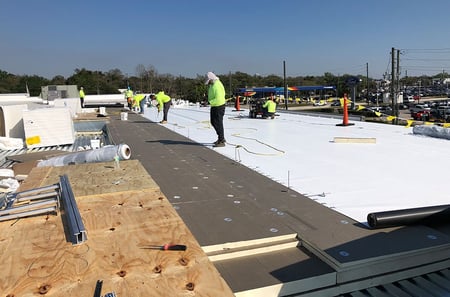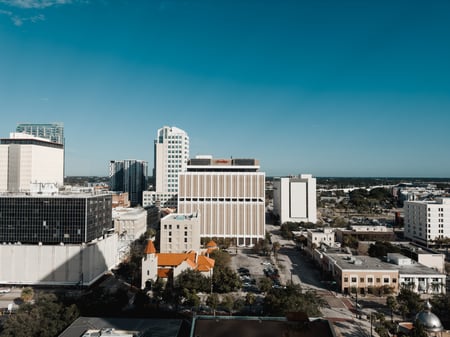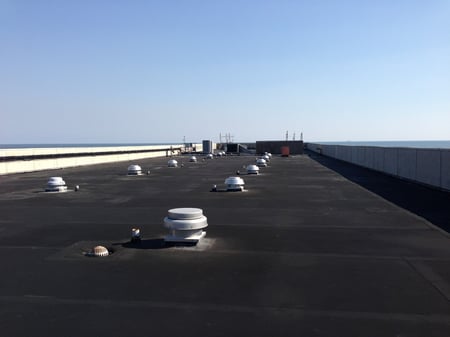What Is Liquid Roofing?
February , 2024 | 6 min. read

Imagine your roof getting a much-needed spa treatment, but instead of a facial, it's getting a fresh, protective coat of liquid roofing. This isn't just any old topcoat; it's like a facelift for your building, whisking away the pesky leaks and UV rays. With liquid roofing, your property is ready to stand tall against whatever natural aging and Mother Nature throws its way.
At RoofCrafters, we think that liquid roofing is just the sort of treatment your building has been waiting for. It's easy to apply, it comes in different colors, and it's like giving your property a little desperately needed TLC, sure to fit every curve and angle perfectly.
Doesn’t that sound nice? Not as nice as an actual facial or even a massage, but, I digress. Still, your property deserves a bit of love every now and then, and liquid roofing may be just what it needs. So, if you’re interested in learning exactly what liquid roofing has to offer, where and why it’s used, and the cost, stick around until the end of this article. Let’s dive in!
What Is Liquid Roofing?

Liquid roofing refers to a type of roofing system where a liquid waterproofing material is applied to the surface of a roof to create a seamless, flexible, and watertight membrane. The most common types of liquid roofing include silicone, acrylic, and polyurethane. The liquid material can be applied using various methods such as spraying, roller application, or brush application.
Once applied, it forms a continuous coating that conforms to the contours of the roof, providing excellent protection against water infiltration, UV exposure, and other environmental factors. Liquid roofing systems are commonly used on flat or low-sloped roofs and are favored for their durability, ease of application, and ability to accommodate structural movement without cracking or splitting. They are a popular choice for both new construction and roof refurbishment projects!
Where Is Liquid Roofing Used?

You can find liquid roofing in a variety of different applications and settings. Most commonly, you’ll spot it in:
.png?width=1200&height=200&name=Recommended%20Reading%20(80).png)
Commercial buildings: Liquid roofing is commonly used on flat or low-sloped roofs of commercial buildings such as offices, warehouses, shopping centers, and factories.
Industrial facilities: Industrial buildings often have large flat roofs that require reliable waterproofing and protection against harsh environmental conditions. Liquid roofing is well-suited for these applications.
Residential buildings: While less common than in commercial and industrial settings, liquid roofing can also be used on residential buildings with flat or low-sloped roofs, particularly in areas prone to heavy rainfall or where traditional roofing materials may not be suitable.
Public buildings: Liquid roofing is often specified for public buildings such as schools, hospitals, and government facilities due to its durability, longevity, and ease of maintenance.
Infrastructure: Liquid roofing can be used to waterproof various types of infrastructure such as bridges, tunnels, parking decks, and walkways, providing protection against water ingress and extending the lifespan of these structures.
Green roofs: Liquid roofing systems can be used as part of green roof installations to provide a waterproof barrier beneath the vegetative layer, helping to protect the building structure while also contributing to environmental sustainability.
Overall, liquid roofing is a versatile solution that can be applied to a wide range of building types and structures to provide reliable waterproofing and protection.
Why Is Liquid Roofing Used?

Liquid roofing is quite popular, and besides its social status, it’s used for several awesome reasons including:
.png?width=1200&height=200&name=Recommended%20Reading%20(81).png)
Waterproofing: Liquid roofing forms a seamless, watertight membrane that effectively prevents water infiltration, protecting the underlying structure from moisture damage.
Flexibility: Liquid roofing materials are highly flexible, allowing them to accommodate structural movement without cracking or splitting. This flexibility is particularly beneficial for buildings located in regions with temperature variations or seismic activity.
Durability: Liquid roofing systems are known for their durability and longevity. They can withstand exposure to UV radiation, extreme temperatures, and other environmental factors, ensuring long-term performance and protection.
Ease of application: Liquid roofing can be applied using various methods such as spraying, roller application, or brush application, making it easier and faster to install compared to traditional roofing materials like asphalt or single-ply membranes.
Seamless coverage: Liquid roofing creates a seamless membrane that conforms to the contours of the roof, eliminating seams and joints where leaks are prone to occur. This seamless coverage provides superior protection against water ingress.
Maintenance: Liquid roofing requires minimal maintenance over its lifespan. Routine inspections and occasional recoating can help extend the roof's life, but overall upkeep is relatively low compared to other roofing systems.
Sustainability: Some liquid roofing materials are formulated with environmentally friendly components, and they can contribute to energy efficiency by reflecting sunlight and reducing heat absorption into the building, which can help lower cooling costs.
Overall, liquid roofing is used because it offers a combination of waterproofing effectiveness, durability, ease of installation, and long-term performance, making it a preferred choice for many building owners and contractors.
What’s the Cost of Liquid Roofing?

The cost of liquid roofing can vary depending on several factors, including the size and complexity of the roof, the type of liquid roofing material chosen, the condition of the existing roof substrate, and local labor and material costs.
As a rough estimate, the cost of liquid roofing typically ranges from $3 to $10 per square foot for materials and installation. However, this range can vary significantly based on the specific requirements of the project.
For example, if the existing roof substrate (the base layer of the roof) requires extensive preparation or repair work before the liquid roofing can be applied, this could increase the overall cost. Additionally, premium liquid roofing materials or specialized application techniques may also come at a higher price point.
It's essential to obtain quotes from reputable roofing contractors who can assess your specific needs and provide a more accurate cost estimate based on the details of your project. Investing in quality materials and professional installation can help ensure the longevity and performance of your liquid roofing system, potentially saving you money in the long run!
Experience The Perks of Liquid Roofing
All in all, liquid roofing is a cost-effective and long-lasting option for protecting and extending the life of a roof. Its seamless application minimizes the risk of leaks and provides a strong barrier against the elements. Business and property owners can benefit from the energy efficiency and low maintenance requirements of liquid-applied roofing, making it a practical choice for both residential and commercial properties.
With its ability to adapt to different roof shapes and materials, liquid roofing offers a reliable and sustainable solution for enhancing the longevity and performance of a building's roof. It provides excellent waterproofing, creating a seamless and durable barrier against leaks. No more worrying about water seeping into your building!
Another perk is that liquid roofing is highly flexible, meaning it can adapt to different roof shapes and materials. This makes it a versatile option for various types of roofs, whether flat or low-sloped. So, if you’re looking for a commercial contractor to aid you in your liquid roofing endeavors, be sure to hit the “Schedule an Inspection” button, and one of our experts will walk you through the process!
My name is Cassie, and I’m the Content Manager here at RoofCrafters. I was born and raised in Chicago, Illinois, and made my way out to Florida post-college graduation. I’m incredibly passionate about writing and creating valuable content that helps others with the collaboration of my marketing team. When I’m not working, I enjoy shopping (a little too much), spending time at the beach, and reading!



